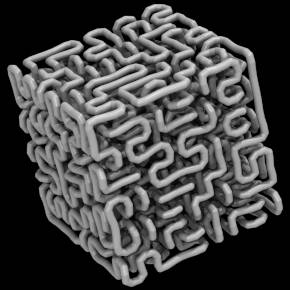This is an example demonstrating how to confine a polymer (eg. DNA) within an arbitrary shaped box (eg. the mature HIV viral capsid, shown in grey). Initially the polymer is confined to a rectangular box (shown enlarged above) which is small enough to fit within the desired container (the viral capsid). The final two images show the initial and final conformation of the DNA polymer (before and after simulated relaxation using LAMMPS). This example uses the "3bp2p" coarse-grained DNA model.
Initially, the conformation of the polymer is created with ndmansfield (a random self-avoiding-curve generator), and then smoothed with interpolate_curve.py, and then re-scaled so that the spacing between points along the curve matches the desired spacing between monomers in the polymer. (These commands can be entered into a terminal running BASH.)
NMONOMERS=3058; # number of monomers
B=0.996 # physical length per monomer
Nx=11; Ny=11; Nz=11 # number of lattice sites
# Generate a lattice polymer shape (integer coordinates)
# Note: You can download the "ndmansfield" source code here:
# https://github.com/jewettaij/ndmansfield
./ndmansfield -box $Nx $Ny $Nz -seed 0 -tstart 1 -tsave 1000000 -tstop 1000000 > curve_lattice.txt
# Interpolate and rescale the coordinates:
SCALE=`echo "($NMONOMERS*$B)/($Nx*$Ny*$Nz-1)" | bc -l` #physical curve length / #lattice sites
interpolate_curve.py $NMONOMERS $SCALE < curve_lattice.txt > curve_smooth.txtThen the genpoly_lt.py, tool is used to create a moltemplate file ("dna_polymer.lt") which defines a polymer which lies along the curve created in step 1 (see above).
# Create a moltemplate file ("dna_polymer.lt") for a polymer with this shape
genpoly_lt.py -helix 102.7797 \
-polymer-name 'DNAPolymer' \
-monomer-name 'DNAMonomer' \
-inherits 'DNAForceField' \
-header 'import "dna_monomer.lt"' \
-bond Backbone a a \
-bond Backbone b b \
-dihedral MajorGroove b b a a 0 1 1 2 \
-dihedral Torsion a a b b 1 0 0 1 \
-padding 20,20,20 \
< curve_smooth.txt > dna_polymer.ltFinally moltemplate is invoked to create a LAMMPS data file and input script containing the polymer (as well as the box that it is contained within).
moltemplate.sh system.lt(Note: The "system.lt" file contains a link to "dna_polymer.lt".)
For a detailed step-by-step explanation of this process (with an abundance of crufty comments), see these two files: "STEP_1_generate_coords.sh" and "STEP_2_generate_LAMMPS_files.sh".
Some of the particles in the simulation form the walls of the container (the viral capsid shell). The are immobilized by excluding them from the group of atoms that is supplied to the integrator. (For details, see "run.in.min", and pay attention to the "group" and "fix nve/limit" commands.)
LAMMPS must be compiled with the "MOLECULE" AND "EXTRA-MOLECULE" packages enabled. If you receive this error message (or something similar): "dihedral_style spherical: Unknown dihedral style", then you must follow these instructions, and recompile LAMMPS.
This example uses the "3bp2p" DNA model described here. The force field parameters were tuned to reproduce realistic geometry and mechanical properties of DNA, including a major/minor groove, helicity, length, persistence length, and torsional persistence length.
Note: In this example, there was only 1 polymer, but you can create a system with multiple polymers (of various lengths) confined in the same box by running the "genpoly_lt.py" script with the "-cuts" argument in step 2. This is a useful way to generate polymer melts. However if the polymers in your simulation are long, then their conformation is likely to be kinetically trapped due to entanglement. In that case, you must use one of the following methods below to relax the polymer to its equilibrium conformation.
It is impossible to equilibrate a long confined polymer using this method. The duration of this simulation is insufficient for a polymer of this length to reach a realistic equilibrium conformation. In this example, the DNA is expected to have a liquid-crystal-like equilibrium conformation, with most of the DNA polymers aligned parallel to each other. But in this short simulation, the DNA remains bent and entangled with itself,
In order to reach a plausible equilibrium conformation, it is necessary to allow the polymer to pass through itself. In LAMMPS the later can be done using any of the following pair styles:
https://lammps.sandia.gov/doc/pair_fep_soft.html
https://lammps.sandia.gov/doc/pair_table.html
https://lammps.sandia.gov/doc/pair_soft.html
https://lammps.sandia.gov/doc/pair_gauss.html
http://moltemplate.org/lammps_code/pair_lj_charmm_coul_charmm_inter.html (Search for "soft-core". Note: This feature requires you to recompile LAMMPS.)
HIV is a retrovirus. During the process of infection, the RNA genome is converted into DNA in a process called reverse-transcription. During this time, some of the RNA will be degraded and will exit the virus. This process is believed to occur inside the conical-shaped capsid shell. (shown as grey spheres in the figure). Some RNA may remain after the process is finished. However RNA was not included in these simulations.
In the real HIV virus, the mature capsid is filled with nucleocapsid and integrase proteins (among others) which are attracted to DNA and RNA. These proteins will dramatically affect the conformation of the DNA and RNA within the capsid, but they were also not included in this example.
I realize this is a complicated example. Hopefully in spite of that, this example is useful.
Andrew, 2020-12-30







